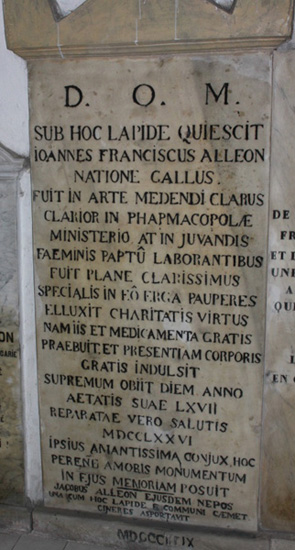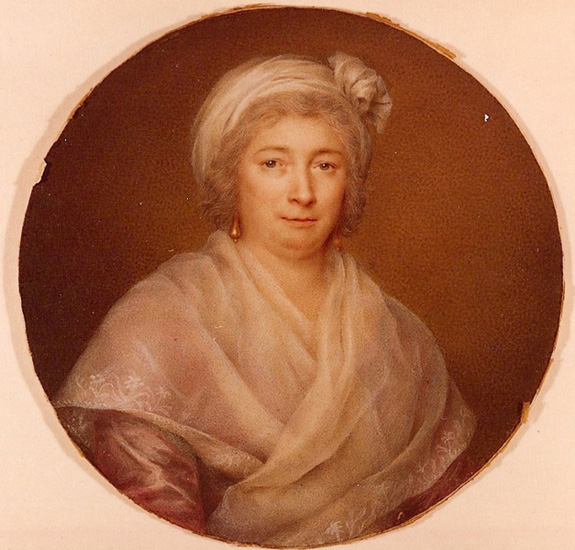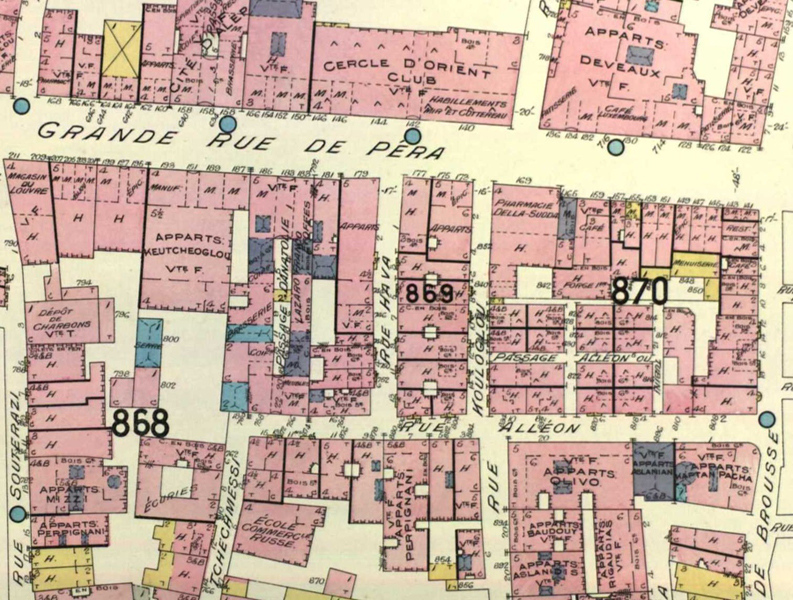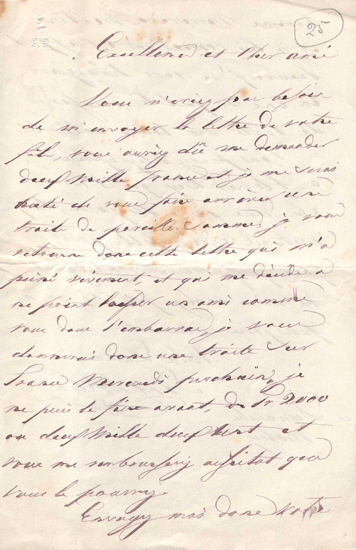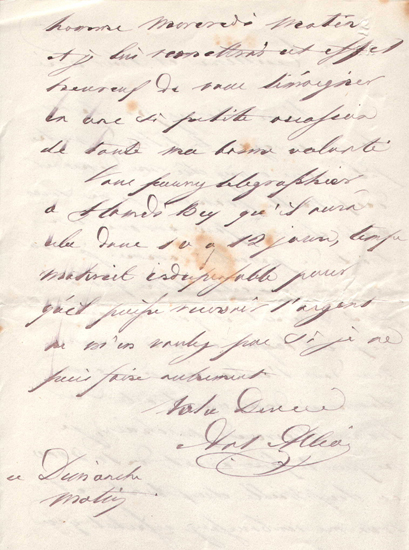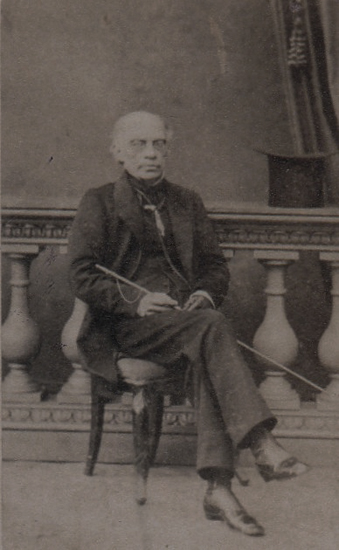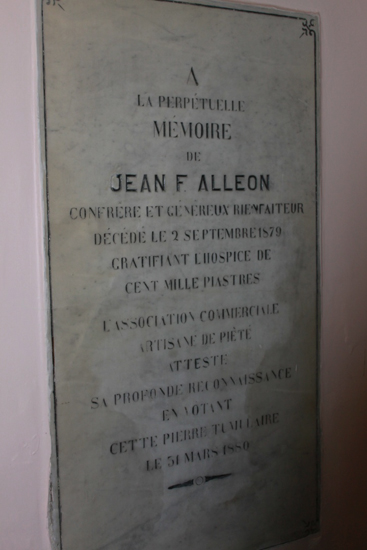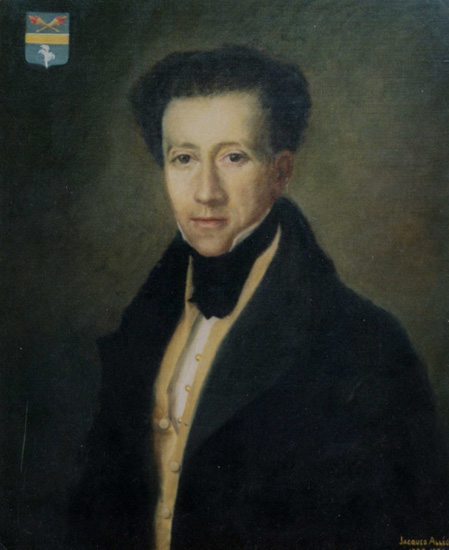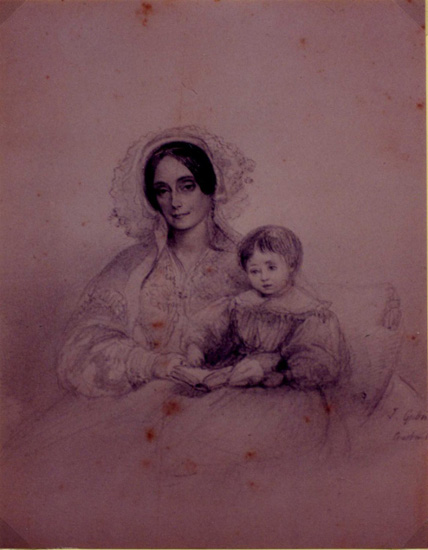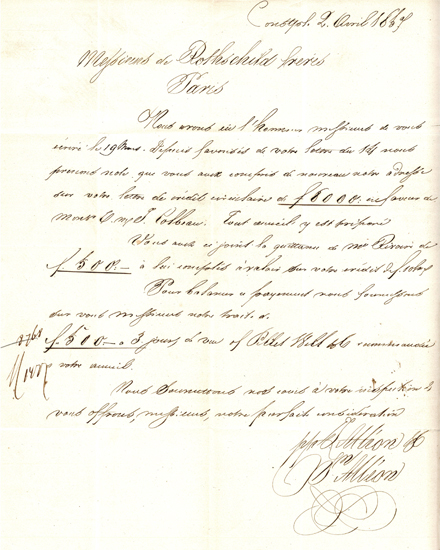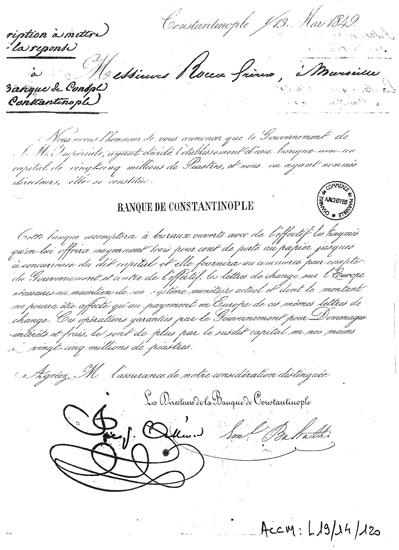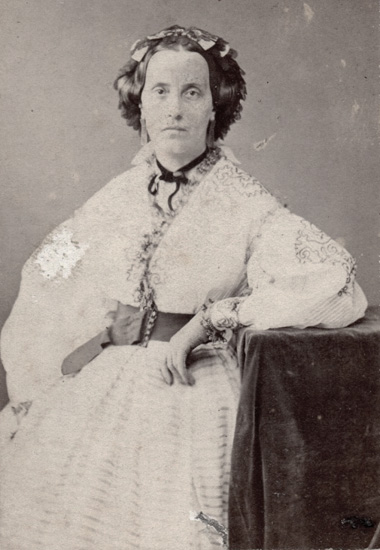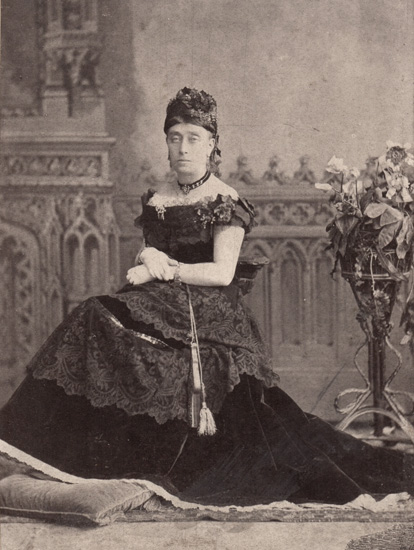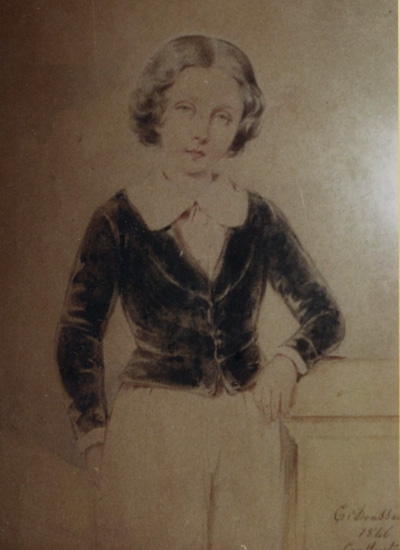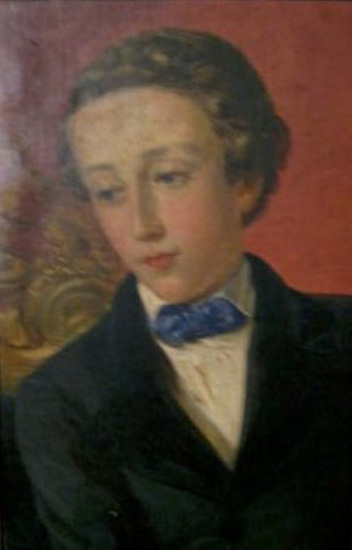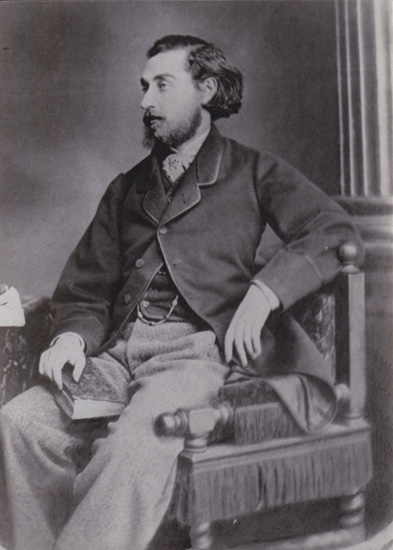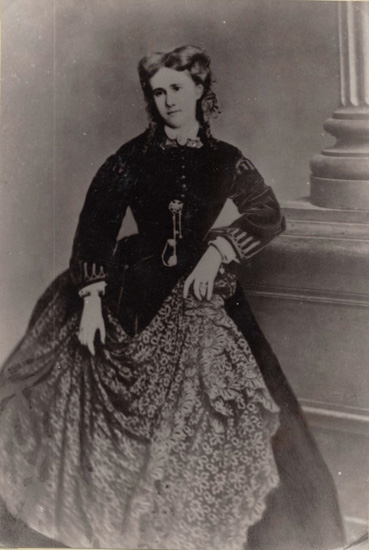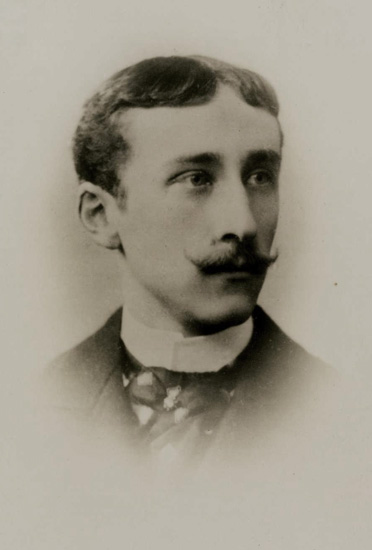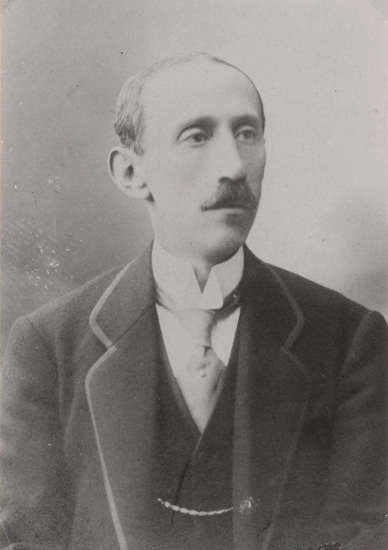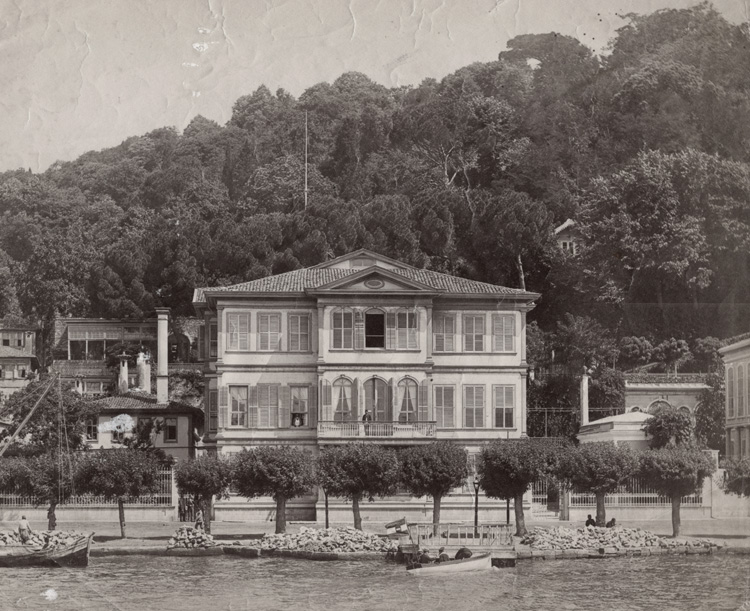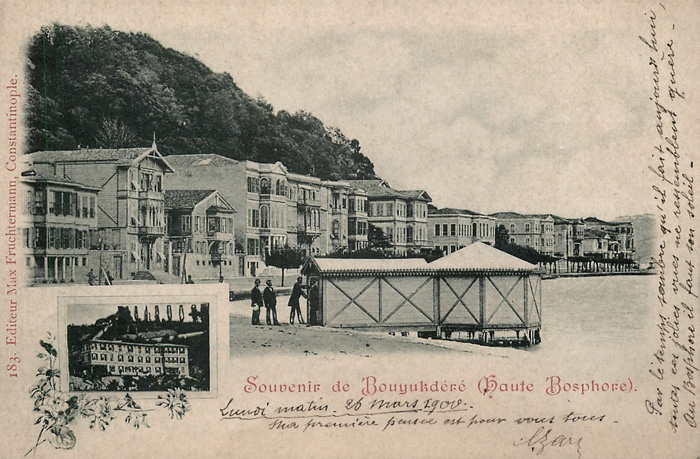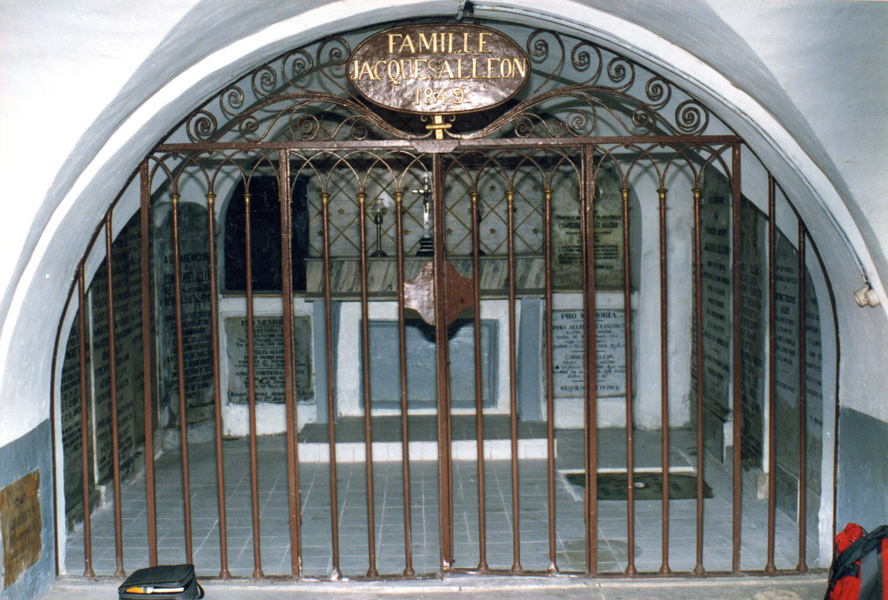
The Contributors
The Alleon Family, Two Centuries of French Presence in Istanbul - version française
by Christophe Alléon

The memory that Istanbul keeps of the Alléon family is that of an illustrious Peran family of the 19th century. Few people know that this fame is due to three rich French financiers, having founded in the middle of the 19th century the first bank of the Ottoman Empire.
Most people don’t know that five generations of Alléon have succeeded each other in Constantinople for almost two centuries.
Here, in a few portraits, is what the Alléon of Pera were like.
First Generation
Originally, there was the grandfather Jean-François Alléon. Eighth of a family of eleven children, who was born in France, in the small Ardèche village of Boulieu, on the 4th of April 1707. His father, an apothecary, taught him his job. Then, probably in one of the faculties of his region, Jean-François completed his training by studying medicine.
Once his diplomas were acquired, i.e. around 1730, Jean-François took the decision to move to Constantinople? It is unclear exactly what motivated such a choice. Family tradition tells us, with the complacency we know, that at that time the Sultan’s favourite was a woman from the same region as Jean-François. Knowing how to treat herself only with herbal potions prepared by the apothecaries of her regions, the young woman would have expressed the wish to have one of these pharmacists at her disposal. This is what would have attracted Jean-François to Constantinople.
He settled in the district of Galata, and worked for the French Embassy, where he officially held the position of Surgeon of the French Nation. His role was of course to treat his fellow countrymen, but also to issue health patents to ships, to assist the French military missions in the region, and to act as a commercial intermediary between his native patients and passing merchants. This status as a general practitioner quickly made Jean-François a recognized and sought-after person in the social ladder, and especially with the seraglio which, let us not forget, would be at the origin of his coming to Turkey.
According to family legend is said to have been in his capacity as the Sultan’s doctor that he was called to the bedside of the seriously ill Sultan’s favourite one evening. Charged to treat her, Jean-François apparently cured her. The sultan would then have decided, to show his gratitude, to offer him something significant. To do so, he would have taken him to a plain, not far from the forest of Belgrade, and would have told him that as far as he could see, the land would belong to him. Jean-François, daring, would then get back on his horse to extend his field of vision and thus, acquire, at a glance, a few more hectares!
Of Jean-François’ long career in the East, one anecdote deserves to be highlighted. When he came to power in 1774, Sultan Abdül-Hamîd I appointed Jean-François as one of his four personal doctors. But Abdül-Hamîd acceded the Osmanli throne with a heavy secret in his luggage. Let the Count of Saint-Priest, the French ambassador to Constantinople at that time, reveal it to us; “It has come to my knowledge a peculiar asserted detail of the physical and corporal state of the Lord Sultan Abdül-Hamîd who ascended the throne at the age of 49. A very essential point for the Empire existence is to see the birth of heirs, his sisters hastened to send him beautiful Georgian and Circassian slaves with the hope of ensuring the succession to the throne, this prince having agreed himself of his current impotence”. So the secret was jealously guarded, and only Abdül-Hamîd’s sister, Esmâ Sultane, had his confidence. In order to help her brother, she had Jean-François called in secret to treat his brother: “This Prince, no doubt at the instigation of his sister Esmâ Sultane, took the decision to call this surgeon and to have him visit him [...] His Highness confessed his impotence, which dated back to a time shortly before his accession to the throne, having had the use of his faculties until then. Alléon found that nothing was missing from the conformation, proposed some remedies to restore the tone of the solids, [...] and promised to begin his healing.” But, without knowing it, Jean-François had just entered an important palace plot. His visit having not gone unnoticed, he was summoned the very next day by the Hékîm Bâchï, the chief doctor of the palace, and had to explain the reason for his visit. From that day on it was reported that the ruler, whose politics were not at all popular, was unable to produce heirs to the throne. At the palace, the eyes of the palace turned to the other suitors of the moment. And there, bad surprise: the Osmanli dynasty had only one at that time: Selîm, the son of Mustafa III. He was then only fourteen years old. And, of course, this only potential progenitor of the dynasty was refused to beget any heir until he took the place of his uncle. As the French ambassador wrote to his minister: “It remains to be feared for him (Selîm) an epidemic misfortune, such as the plague and smallpox. One cannot help but shudder when one thinks, if one had the misfortune of losing him, of the unrest that would inevitably tear the Ottoman Empire apart during the rest of the reign of a prince as weak as the reigning sultan and especially after his death... The need to have heirs to the Empire will force him to the throne.” At the palace, some people intrigued to prevent Jean-François Alléon from treating the impotent and unpopular Ottoman sultan. Saint-Priest does not say what influence Jean-François Alléon had on these events, but the fact remains that Abdül-Hamîd I later had children, including a son, Mahmûd, in 1785 (the future Mahmûd II, Sultan from 1808 to 1839). As for the young Selîm, he had to wait for the death of his uncle, in 1789, to succeed him.
In addition to the rubbing shoulders with one of the most powerful men in the world at that time, Jean-François was one of the few Westerners to be admitted to the Topkapi seraglio. He and his wife, who gave birth there, had the immense privilege of having access to the interior of the imperial harem.
Jean-François Alléon led a busy career in Constantinople. It was in this city that he died on December 30, 1775, at the age of sixty-eight.
He had married, on May 3, 1747, in the church of St. Peter St. Paul in Galata, Thérèse Marchand, a young woman of whom almost nothing is known, and who survived him until 1815.
From this union were born in Constantinople four children:
- Marie-Madeleine (know as Yaya), born September 11, 1749. On November 20, 1775, she married a French merchant from Lyon, Ange Rambaud (1733-1807), who had lost his mother and older brother to the plague in Constantinople. Returning to France in 1785, she saved her husband from the guillotine during the Revolution. Indeed, he had been sentenced to death, but she regularly backed away from the day of the execution, gradually giving her money and all her jewellery to her jailers, until Ange Rambaud was released on 26 May 1795, after the fall of Robespierre. Marie-Madeleine Alléon died in Marseille on March 18, 1847, at the advanced age of 98.
- Catherine, born on May 4, 1757, she married Pierre Olive, a merchant from Marseille, on June 2, 1782. Returning to this town in 1787, she was a neighbour of her sister Marie-Madeleine on rue Grignan. Catherine died, like her sister, in Marseille at the age of 97 (January 11, 1854).
- Claude-François, born March 13, 1761. He died without prosperity in Constantinople at the age of 23 (September 18, 1784).
- Jacques, who was the only child of Jean-François to be born in Constantinople. He is the father of the three famous financiers. Between the beautiful story of the imperial doctor grandfather and the rich history of the financial grandsons, the short story of the father might seem tenuous. Indeed, Jacques died at the rather young age of 48. He did not achieve great things in his life. But the fact that he suffered the torments of French history in Constantinople which makes his life very interesting. Here is his portrait in a few lines.
Tomb stone of Jean-François Alléon (1707-1775) | Marie-Madeleine Alléon-Rambaud (1749-1847). In Marseille, she continued to wear the traditional Levantine scarf and turban.
Second generation
Jacques François was born on May 10, 1753. At the age of 10, he went to France to study and returned to Constantinople a few years later, and in 1775 he worked as a clerk in a trading house of this town. After twelve years of experience, he founded his own establishment in 1787. He brought all kinds of goods from France by boat and sold them in Constantinople. The ships would then sail back to France, loaded by him with Turkish products. Unfortunately, it was not a good time because two years later a period of great turmoil and instability began in France: the Revolution.
This was not without consequences for the merchants of this country, settled in Constantinople: the French ambassador, who representative of the king, was relieved of his duties, and the new diplomats of the embassy, representatives of a regicidal government were very unpopular in the seraglio as in the Vatican (all officials of the Republic were excommunicated by the pope), were almost forced to resign. Without diplomatic support and left to their own devices, eight of the twelve merchants in the Constantinople trading house had to gave up their French nationality to seek the protection of other nations and thus preserve their interests. Jacques Alléon chose to remain loyal to his country. It was not the right option. He faced several difficulties, such as the confiscation of his goods he sent to France as part of his commercial activities. However, somehow he managed to get out of the revolutionary episode by avoiding bankruptcy.
On July 2, 1798, soon after Jacques had recovered from the effects of the French Revolution, a new crisis broke out: Bonaparte’s invasion of Egypt. This country had been under Ottoman domination for more than three centuries. As soon as he learned of this invasion, on September 8, Sultan Selîm III declared war on France. A wind of madness then blew over Constantinople. Anything that had anything to do with France was a target for the Ottomans’ revenge. Disregarding the laws of war and the inviolability of the chancelleries, the Turkish armies organized a vast manhunt that lasted for several days, during which no one was spared: diplomats, merchants, craftsmen, religious all were apprehended and held captive. All their belongings were confiscated and sold. But, very quickly, and on the strength of his painful experience during the crisis of the French Revolution, he asked for the protection of the Republic of Ragusa to save his interests. The renunciation of his nationality enabled him to avoid the long captivity that his compatriots had to endure, since they were all imprisoned until the end of the French campaign in Egypt, in September 1801.
It is precisely in this month of September 1801, on the 12th, that Jacques Alléon died. He was 48 years old.
He had married Sophie Fonton in 1790, a young woman in her twenties. Sophie came from a large French family of Dragomans who had lived in Constantinople since 1670 and with her had seven children. An amusing detail, in France, the Fonton were originally from Alixan, a village less than fifty kilometres away from the Alléon village! At the time of his death, the oldest child was nine years old, the youngest thirteen months.
The four girls were:
- Marie. Baptized on November 29, 1793 in St. Peter and St. Paul, she married Philippe Romani on April 28, 1822, later Denmark’s first dragoman in Constantinople. She died in January 1864.
- Thérèse. Born January 27, 1795 in Constantinople, she married on October 1, 1821, the first dragoman of the British Embassy in Constantinople, Frederic Pisani. Thérèse Alléon died on December 1, 1877. The Pisani family were Venetian, and like Frederic, many of its members were dragomans or diplomats.
- Françoise. Born in 1798 in Constantinople and baptized at home, we know nothing more about her.
- Christine. Born August 3, 1800 in Constantinople. Wife of Jacques Salzani, a banker from the province of Naples (more precisely from the village of Cava de’Tirreni), whose grandfather Domenico (1705-1760) arrived in Constantinople around 1740 as Consul of France. Christine died on November 19, 1836 in Constantinople, leaving at least three children.
The three sons were Jacques (1792-1876), Antoine (1797-1881) and Jean (1799-1879). These are the three famous financiers, who marked their time and their city. As a result of the father’s absence, it was Jacques who, very early on, protected the siblings. Professionally, it was also he who led his brothers in their careers. Thus, Jacques was the showcase, the flamboyant leader. Contemporary of the Rothschilds, Fould, Pereire and Sina (the richest man of his time), he was also their friend. Antoine and Jean came in the back. They were the administrators, the managers. So it is mainly through the portrait of Jacques that we are going to present their actions.
Third generation
Jacques, François Antoine, was born on July 20, 1792 in Constantinople, almost at the same time as another great financier of the 19th century whom he knew well: the future Baron James Mayer de Rothschild. After studying at the College of St. Benedict in Constantinople, he began his career as a clerk for the city’s merchants, Stephani Stephano until 1818, then Auguste d’Alayer. From this passage, we will remember that Jacques was involved in the already very lucrative trade of war munitions.
In 1822, at the age of 30, Jacques, anxious to stand on his two feet, joined forces with a merchant 38 years old his senior, George Cingria, to found a trading house. The association was short-lived, because exactly one year after having obtained a licence from the French authorities, Georges Cingria died. On the foundations of their establishment, Jacques then built his own trading house: the Maison Jacques Alléon et Cie. Two of his main partners were, of course, Antoine and Jean. The Alléon brothers quickly moved from trading to finance, the two activities being closely linked at that time.
The first twenty years of Jacques Alléon’s activity led to the rise of his establishment, which brought him to the head of the Turkish financial centre. As a result, his main client was very quickly the Ottoman government, for whom he became the man to trust in matters of finance. Thus, we find him many major operations related to the Sublime Porte such as:
- The collection of Greece’s emancipation debt to Turkey (1834),
- The immense work of collecting the old copper coins of the Empire (1834-1842),
- The loan of large sums of money to the Treasury (1840),
- And, by far the most lucrative, the Empire’s income from leasing. Indeed, like the general farmers of the old regime in France, Jacques Alléon advanced to the Treasury the amount of taxes in certain regions (Smyma, Macedonia) to be reimbursed by recovering the funds directly from the taxpayers of the province in question. It is easy to imagine the enormous profits Jacques must have made from these operations. In addition to these actions on the behalf of the government, Jacques Alléon carried out others on his own account, such as the export to London in 1840 of large quantities opium, at a time when the British Empire was experiencing a serious shortage of this drug, since it was at war with China over it.
These twenty years of prosperity brought Jacques Alléon and his brothers’ wealth, recognition from the major European bankers, and confidence from Turkish officials. However, the financial situation of the Ottoman Empire was bad. The state’s revenues were poor. Some were still being collected in kind! (hence the usefulness of handing over taxes to traders). On the other hand, the army alone absorbed almost everything that went into the Treasury. The government, constantly short of cash, had long been reduced to using expedients to get money. One of them was to make a profit on coins, minting a lot of them. But this had disastrous consequences. It disrupted the trade, which, in order to get by, exported what little good gold and silver coins the Empire had: the bad coins drove out the good ones. This flight of precious metals caused the exchange rate of the Turkish piaster to rise in the relation to European currencies, and eventually panicked the government. The government asked Jacques for advice. As a financier, he advocated a whole series of measures that he considered indispensable to put in place. These included: the withdrawal of all altered currencies, the creation of a new gold and silver currency, the development of agriculture, a policy for the government to maintain the exchange rate on par with Europe, and others. He further specified that all these measures were dependent on each other.
The government offered him to take responsibility for the last point mentioned, with the support of another powerful local banker, Theodore Baltazzi. It was in this context that the two men signed a contract with the Sublime Porte on May 25, 1843, with the aim of maintaining the exchange rate for one year, while the Ottoman ministers undertook to carry out the other points advised by Jacques.
It is interesting to note that it was through this contract, on this date and with these two financiers that the first bank in the Ottoman Empire was unofficially formed. It was a bank of state and issue. It had the privilege of issuing interest-bearing banknotes, the Caimas.
Unfortunately, after a few months, Jacques realized that the only contractual point respected by the government was the creation of a new currency. And the mint was still making money on the creation of the new currency. Jacques explained to the Sublime Porte that he and Baltazzi were able to meet their commitments only thanks to their credit and the trust placed in them by their European partners (mainly the Rothschilds and the Sina). As a result, they no longer wished to continue in these dangerous conditions. But the government forced them to do continue with their duties and they were obliged to accept.
Personal problems between Jacques Alléon and Théodore Baltazzi forced the latter to be replaced by his brother Emmanuel for the following years. But this change at the head of the bank did not affect its activity in any way. Thanks to this partnership, the policy was maintained, and as a result, the Ottoman trade and government were able to breathe. The establishment was getting structured, seconded with agents within the Empire (Salonika, Mosul...), in Europe (London, Marseille or Paris), and fulfilled its main function with some success, despite the French revolutionary crisis of 1848 which shook the European and Turkish states. In 1849, the bank took the official name of Bank of Constantinople (Der Saadet Bankasi). The capital deposited by the government was 25 million piasters. Emmanuel Baltazzi and Jacques Alléon took over as directors of the institution. But this bank, due to the absence of a government financial policy, was only able to maintain the exchange rate on par by giving large losses to the Treasury (12 to 15 million piasters annually) and especially thanks to the special guarantee and the esteem its managers had among European financiers.
After a few years, the failure to implement the financial reforms called for by Jacques Alléon, the beginnings of the Crimean War, but also and above all the negligence and the incompetence of Ottoman officials in financial matters inevitably brought this bank to its knees. This last point deserves to be developed, because there is no shortage of examples of irregularities in this area:
- Failure of the Minister of Finance to make necessary calls for funds for the payments of the due dates in Europe.
- Perpetual abuse of the mint over-producing,
- Ministers who happily drew from the bank’s coffers, even going so far as to cut into the very capital of the institution,
- Daily borrowing of colossal sums of money by the Minister of the Mint and the customs leaseholder of the Empire to finance the Sultan’s civil list.
- Nafiz Pacha, the Minister of Finance, would even go so far as to borrow from the existing Caimas, only to have them repaid a few months later by others, which he himself had cancelled.
Having, as his associate Emmanuel Baltazzi, widely damaged his reputation in this experience and Jacques Alléon asked permission from the Grand Vizier to resign on March 1, 1851. However, as he could not find a replacement, he agreed to continue as director, out of complacency. He nevertheless requested a liquidation on that date. The Sublime Porte listened to him, but did not react until January 1853. It then appointed a liquidation commission (composed of Greek financiers from the city), and the Bank of Constantinople ceased to exist in the course of 1853.
Despite all that has been written about it, the Bank of Constantinople came to an honourable end. The scandal and public bankruptcy of the Turkish state was avoided. Barely, but they were. The liquidation went smoothly and without the additional bankruptcy of any commercial establishments. Jacques Alléon had a lot to do with it. However, he came out of this adventure weakened.
At then end of this painful experience, he was sixty-one years old. As he himself wrote in a letter to the first secretary of the French embassy, Count Vincent Benedetti, he wanted: “to withdraw forever from the financial affairs of this country, because they had almost made him lose honour, credit and fortune”. He could have stopped working and lived on his pensions, he had enough resources left. He did not; he decided to continue, but in a different direction.
First of all, his thirty years of experience in Ottoman finance allowed him to continue working with the Sublime Porte, but without any further personal commitment on his part. Indeed, we find him in many projects, where Jacques was content to act as a consultant:
- Adviser during the loan that the Porte wished to contract with the Pereire family (1856).
- Adviser on the draft statues of a new bank (1857).
- Official adviser to the Turkish Minister of Finance (1859).
- Liquidator of the so-called “Greek Houses of Marseille” case (1861).
At the same time, Jacques invested heavily in real estate. There was an expression in Constantinople at the end of the Empire that said “Alyon kadar zengin”, which could be translated as: “as rich as Alléon”. This expression, taken up in the Istanbul ansiklopedisi, by Resat Ekrem Koçu, which testifies to the wealth of the Alléon brothers at that time. Jacques invests in Péra first, he had the Cité Alléon built, a complex of four buildings, all containing 48 apartments and a few shops for rent. Alléon Street, Alléon Passage and Alléon City were built between 1870 and 1876. The old Alléon street is now called Gazeteci Erol Dernek sokak. The old Alléon city is called Alyon geçidi. In this street, in 1891, lived doctors, bankers or high-ranking civil servants, which testifies that at the time of the Alléons the neighborhood was residential, that of the wealthy class.
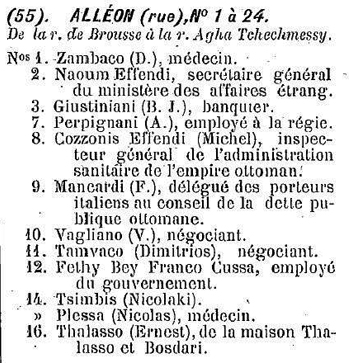
Cervati Yearbook of 1891, page 632.
Charles Goad plan of 1905 showing the street, the passage and the Alléon block.
Then in Paris, he bought or had built several mansions, new buildings equipped with sewerage, water and gas, near to Baron Haussmann, and which can still be seen today around the opera house (rue Volnay, rue Scribe, rue Auber...).
Finally, we find him as early as 1858 with the man who claimed to be his friend, Ferdinand de Lesseps, in the construction of the Suez Canal. He took part in the financing of the project, and was on the first board of directors of the famous Suez Canal Universal Company.
In 1863, after his only son refused to resume his activities, he sold his business to one of his associates, Vincent Crespin, and retired to France. Jacques Alléon lived there for seven years, in the Paris region, in his château of L’Etang-la-ville. But in 1870, the hostile events in the capital (siege of the city by the Prussians, followed by the revolutionary episode of the Paris Commune) made him retreat to his native city of Constantinople.
He died there on January 30, 1876, almost at the same time as his former Viennese collaborator, Baron Georg Simon Von Sina. His trading house had probably already disappeared as a result of the sudden death of Vincent Crespin in 1866.
Jacques Alléon was a famous man during his lifetime, but he fell into oblivion after his death. History ignored him. Books specialising in Ottoman finance generally quote a sentence about him, associating his name with the creation of the Bank of Constantinople. But they only remember the failure of this enterprise, implicitly attributing it to him because of the role he played. We now know that he had nothing to do with it. On the contrary, he, who believed in modern Turkey, was one of the first Frenchmen to work with the Ottoman state in a sector other than the military. If it is undoubtedly a little daring today to assert that he was the founding father of the Turkish monetary system and the eminence rise of its Ottoman reformers (he worked in their shadow), we must nevertheless admit that none of the powerful Armenian, Jewish or Greek sarrafs who preceded and succeeded him, showed as much will to modernize the Empire. He also remains, let us repeat, the creator of the first banking establishment in Turkey. This alone, enables him to present himself with a high forehead in front of posterity.
As an anecdote he was also, between 1832 and 1860, elected ten times deputy of the French nation in Constantinople, i.e. representative of the French trade in this city, which is a record of longevity in its 308 years of existence in this function.
Ennobled as a count by Pope Gregory XVI in 1838, he had the exceptional favour of having his title recognized by Napoleon III in 1866. He was also a knight, the officer of the Legion of Honour (1852), commander of the Turkish orders of the Nishan Iftihar and Medjidié, knight of the Roman order of Saint Gregory the Great, of the Spanish order of Charles III, of the Russian order of Saint Nicholas, of the Portuguese order of Christ, to mention only the most important decorations and titles.
Jacques Alléon married on July 15, 1820 Marie Marion (1797-1884), the daughter of a Livorno merchant (François) and Clara Bratis. The couple Jacques-Marie had a total of nine children, all of whom were born in Péra or Büyükdere. Several did not reach adulthood: Felix died in 1822 at just one month of age, Thérèse in 1832 at nine months and Charles in 1838 at the age of thirteen The latter had left to study in France. He died in Marseille, far from his family. Another of Jacques’ daughters, Célestine, died at the age of twenty in 1841. Probably she must have had a heart defect, because after an exhausting pregnancy, she died of cardiac arrest the day after delivering a stillborn child.
The other five children were:
- Adelaïde, born April 3, 1823. She married in Constantinople on October 31, 1842 Joseph Cor, widower of her elder sister Célestine, and later Assistant Director of Foreign Affairs and Professor at the Collège de France. This son-in-law of Jacques Alléon is said to have been eminent in the rise of the great reformist vizier Mustafâ Rechîd Pacha, particularly during the writing of the Gülhâne edict. Adelaide had only one child, who embarked on a diplomatic career. She accompanied him in his transfers and died in Hamburg on March 8, 1895.
- Elisabeth (known as Babeth). Twin sister of Adelaïde, she married Jean-Lucien Rouet in 1842. Jean-Lucien (1812-1871) and his brother Simon (1818-1848) had left their village of Saint-Germain Chassenay, France, to embark on a diplomatic career in Constantinople. Jean-Lucien was chancellor of the French Embassy and then principal agent of the Messageries Maritimes. Mother of five children, she died a few months before her father on May 27, 1875.
- Fortunée was born on August 18, 1824. She married a dragoman from the embassy Auguste Peltier on July 4, 1844, and gave him four children. She died on December 6, 1903.
- Marie-Louise, was born on August 3, 1833, she married the Frenchman Eugène Perruchot de Longeville (1824-1901) on 18 January 1855. Eugène had arrived in Constantinople in 1846 as a young linguist. He ended his career as Minister Plenipotentiary of France. Having had six children, Marie-Louise died in Paris on July 29, 1885.
- Finally, Amédée, who devoted his life to his passion for natural sciences. But before telling his story, let’s go back to Jacques’ two brothers, starting with Antoine.
Antoine, Theodore was born on March 31, 1797 in Constantinople. A student, like his brother, of the Lazarist college of Saint-Benoît, he walked, as we have said, almost all his life in the shadow of his elder brother. However, Antoine was also a great financier of his time.
It would appear that his role in the Alléon banking house consisted more particularly in maintaining the relations side of business, particularly with the Turkish authorities. Indeed, it was always Antoine that we find in the official meals or palace receptions, and this in the name of the Alléon brothers. He was also, on behalf of the Ottoman government, a member of a not inconsiderable number of financial commissions: settlement of the unpaid bill for the lighting of Péra (1849), settlement of a debt between France and the Porte concerning the regency of Tripoli and the affairs of Syria (1846), to give just two examples. At this stage, it is also interesting to recall Antoine’s participation in the creation and then management of the municipality in Péra (1855-1858). But he was above all a great banker, and for this reason he was decorated with the Legion of Honour as a knight by the French government (1850) and a cross by the Vatican (1863).
When his brother ceased his activities in 1863, Antoine thought of doing the same, “after a career of fifty years”. He didn’t have the opportunity to do so. Asked by the French government to participate in the creation of the Ottoman Imperial Bank, he accepted the role of director that was offered to him. He was therefore a member of the first committee of this institution. The Ottoman Imperial Bank had issuing privileges. It is for this reason that we find Antoine’s signature on Ottoman banknotes from 1863 to 1881!
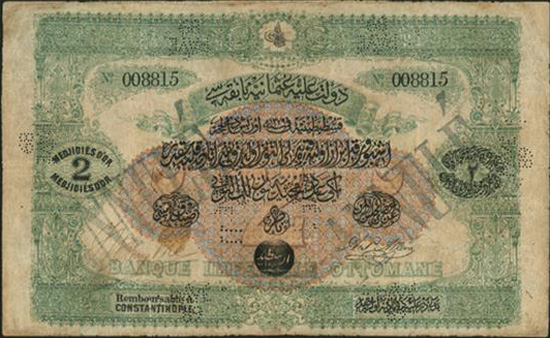
A 2 Medjidiés banknote from 1869
Undated letter, from Antoine Alléon to his friend Edhem pacha, about the financing of his son’s studies.
Antoine Alléon, whose fortune was estimated at twenty million francs in 1863, seems to have left his town very little during his lifetime. Oddly enough, he died in Courville, France, on April 25, 1881. The explanation is comical! This former favourite of the Sultan had indeed had to flee the Ottoman capital in 1875, after the kidnapping of his two goddaughters, Hélène and Amélie Galenzi, from their mother Euphrosine Petrococchino. Indeed, at the time of the death of their father (Dr. Thomas Galenzi). Antoine had sent the two young girls to a Catholic convent in France. He joined them, married them off, and lived the rest of his life with Hélène, whose husband, Abel Scohyers, was a Justice of the Peace. The family had his body repatriated to Pera in the year of his death. He is therefore still in his native town where he is buried. He died a bachelor and never had children.
His brother, Jean, François was born on July 12, 1798 in Constantinople. He is the most obscure of the Alléon brothers. Very little is known about him. He is said to have managed a bank in Paris, which would explain why there is so little information about him in Constantinople.
In 1846, he had married Honorine daughter of Mateo Stiepovitch, Prussia’s first dragoman in Constantinople. She died in 1861, without having given him a child. There followed a trial with her in-laws, which lasted for four years, over Honorine’s inheritance. Jean won, but this trial has remained in the history of the Levantines as a fine example of legal complexity, mixing consular protection and local traditions. Jean died in Büyükdere on September 2, 1879. Curiously, he is not buried next to his wife and parents in the family crypt. Very invested in the Artigiana association, he bequeathed part of his fortune to this association. A dedication stone tablet recalls his generosity in the association’s Catholic chapel (a chapel built by his brother Jacques, when he was president of the association and his daughter Célestine died).
Jean Alléon (1798-1879) | Dedication tablet in homage to John, located to the left of the entrance to the chapel.
Like his brother Antoine, Jean had previously adopted a god-daughter, Marie Isakian. The orphaned child had been raised at Jean’s expense with the Sisters of Charity until the day of her marriage.
Jacques Alléon (1792-1876) | Marie Marion-Alléon (1797-1884), and her son Amédée Alléon (1838-1904)
Letter from the Alléon brothers to the Rothschilds, 2 April 1857. (The trading house Jacques Alléon et Cie was a partner with the Rothschild house in Paris, each representing the other in their respective cities) | Letter dated March 1, 1849, where Jacques Alléon informs the Rocca brothers about the creation of the Bank of Constantinople.
Additionally: letter dated 4/10/1851, from Jacques Alléon to Reschid Pasha, concerning the bad state of the Banque de Constantinople | letter dated 25/03/1853, from Jacques Alléon to Sultan Abdülmecid I, again concerning the poor state of the Banque de Constantinople | letter dated 13/05/1853 from Jacques Alléon to his friend Baron Sina, from Vienna, where he informs him of a change of government favourable to their banking business. | letter from the Alléon brothers to Rothschild of Paris, dated 22/08/1860, concerning embassy salaries (the Alléon were responsible for paying the salaries of Ottoman embassy staff)
Sophie-Adélaïde Alléon-Cor (1823-1895) | Aimée Marie-Louise Alléon-de Longeville (1833-1885)
Fourth and Fifth Generation
Let us now return to Amédée Alléon, the last son of Jacques. He was born on October 8, 1838, in Büyükdere, only a few days before the death of his brother Charles. He was therefore the only Alléon of his generation to be able to pass on the family name.
After a golden and uneventful childhood on the shores of the Bosphorus, his father pushed him into adulthood in 1863. It was an important year for Amédée. He was twenty-five years old. Jacques offered him to resume his activities, which he refused, as we know. So Jacques sold his business. He knew that the fortune he was leaving to his son was large enough that fate could not have dealt him a blow. He then wished to marry Amédée to a young French –educated girl, and made this known. Through their mutual friend, the Viscount de Montesquiau, he was put in touch with Baron Alfred Asselin de Villequier. This native of Normandy still had a daughter to marry, Madeleine. Interviews were held, they pleased each other, and things were decided. Amédée Alléon and Madeleine de Villequier were married in Paris on October 2, 1863. Finally, to end this pivotal year in Amédée’s life, Jacques asked the Vatican is his title of count, initially granted for life could be transmitted to his only son. It was accepted on December 11th. Amédée thus became, like his father Count Palatine, in short, through the blessing of His Holiness Pius IX.
If Amédée Alléon refused to embark on a financial career, it was because he had a passion. He had shown an early interest in the arts and nature, especially birds. He spent his time sketching bird poses from nature, and then reproduced them with examples stuffed using special techniques. His observations led him to explore all the shores of the Bosphorus, but also, to make long stays in France and throughout South-Eastern Europe. He was one of the first to explore, list the winged inhabitants, and explain the migrations of certain birds from Roumélie (Turkey of Europe), present-day Bulgaria, and Romania.
Amédée Alléon paid very little attention to his research, collections and publications. He communicated little, did not showcase his work. He was, however, a member of the Zoological and Entomological Societies of France, and of the Permanent International Committee of Ornithology. He was rewarded for the works he presented at the universal exhibitions in Vienna (1884) and Paris (1889).
He donated three of his four collections of stuffed birds: to a friend, Jules Vian, to the Ottoman imperial government (1864) and to the French Lazarist College of Constantinople (1889). These were subsequently scattered. He sold only one stuffed bird, of a thousand copies, to the Bulgarian Museum of Natural History, which he had founded. One can still admire it nowadays. The French National Museum of Natural History in Paris had acquired and still retains a few examples of the Alléon collections. Amédiée is also the author of two works which, although different, have the same title: Nouveaux procédés de taxidermie (1889 and 1898), as well as several scientific studies. In history, there is no shortage of examples where a father had a genius or talent, and his son neither, contenting himself with taking advantage of the inheritance by giving himself the advantageous attitude of an artist. For Amédée this is partly true – he sold a large part of his father’s inheritance to lead an expensive lifestyle – the fact remains that Amédée’s studies have stood the test of time, showing that he had a real talent as a naturalist.
Amédée Alléon died on January 16, 1904 in Makrikeuy (the current Bakirköy), of a stroke, in the large house he owned on the banks of the Marmara. His wife, Madeleine Asselin de Villequier, was a young French noblewoman from Normandy. She had left her family and her native region to follow Amédée to Constantinople. She survived him until April 13, 1911. Amédée and Madeleine had five children:
- Inès, born on May 1,1865, in Büyükdere, died in Constantinople, a city she had never left, on October 7, 1930. Married to Paul le Mesle, a French annuitant and widower, who had a daughter from his first marriage (Madeleine le Mesle, 1886-1971). Having had no children, Ines raised her daughter-in-law Madeleine.
- Marie, born August 2, 1866 in Dieppe, and died on October 4, 1946 in Courbevoie. She lived a large part of her life in France, and remained single.
- Irma, born on August 16, 1867 in Constantinople, she married her first cousin Eugène de Longeville in 1889. She had three children with him.
- Maurice was born on February 22, 1870 in Büyükdere. He was a pensioner and for a time worked for the Natural History Museum in Sofia (1905 to 1908). Maurice had married a Peran, Evelyne Mille (1876-1972), whose father Edouard was a grain merchant. He returned to France with his wife and eight children at the end of the Capitulation in 1923. He died in Paris on July 31, 1957.
- Abel was born on October 4, 1871 in Constantinople. He would have had a trading house in Pera. Abel died prematurely on May 23, 1915, following a surgical operation. He married in 1897 Malvina Dussi, who was also the daughter of a grain merchant, Noël Dussi (1828-1908), who was called the Prince of the Danube at the time because of the importance of his professional activities. Abel had four children. His family returned to France after the armistice of 1918.
Amédée Alléon (1838-1904) at 8 years old | Amédée Alléon (1838-1904) around 13 years old
Amédée Alléon (1838-1904) | Madeleine Asselin de Villequier-Alléon (1844-1911)
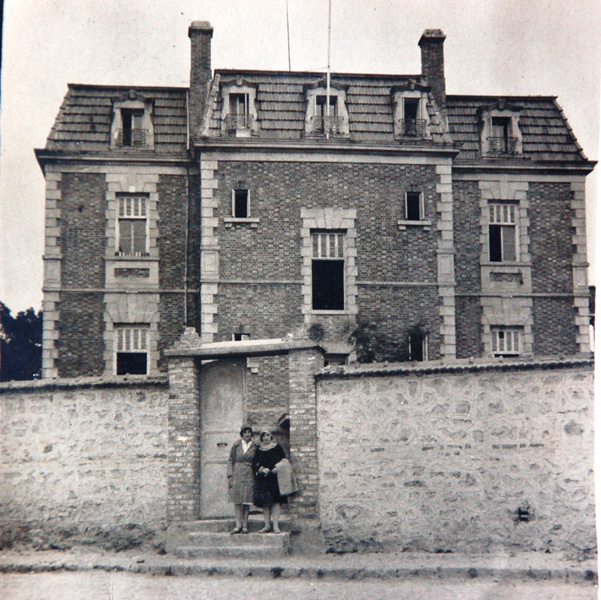
Taş Okul [Stone school], the house that Amédée Alléon had built in Makrikeuy in 1865 with tiles and bricks that he had specially brought from Marseille. He kept this house until the earthquake of 1895. Renovated in 2013, it is now a school.
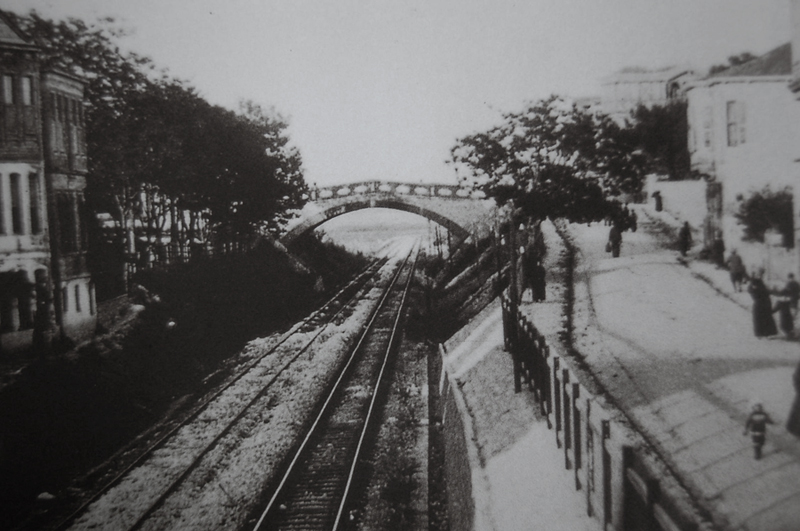
As a railroad passed behind his house, Amedee also had a bridge built over it...
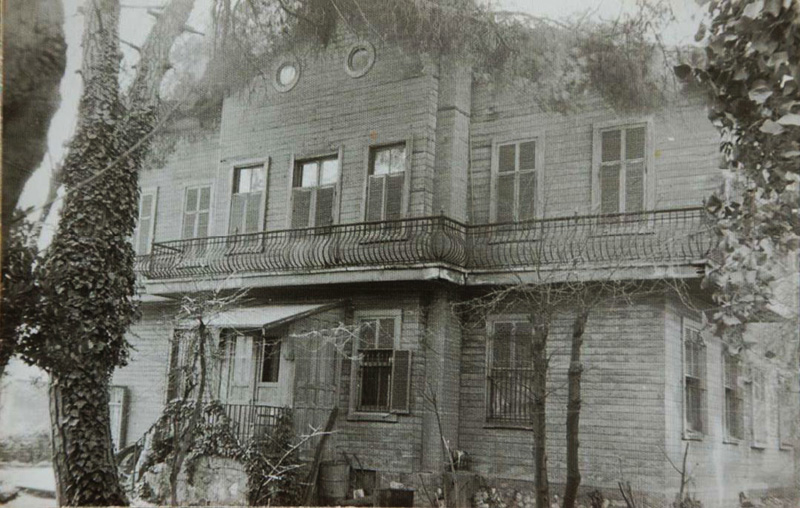
Amédée Alléon’s second home in Makrikeuy, built after the 1895 earthquake.
Maurice Alléon (1870-1957) | Abel Alléon (1871-1915)
The return to France was not easy for the younger generation. Paris, Marseille, Rennes, so many points of fall that the family, once united, found itself scattered. Then, if France was their homeland, it was not their country. Many had never been there. Post-war France had its culture, but it was not their culture either. As immigrants in their own country, they experienced the difficulties of integration. Finally, the departure from Turkey had done away with the family patrimony. Everyone had to enter the labour market. Like their elders, many naturally tried their luck in the French colonies (Morocco, Tunisia, Senegal, Indochina ...). But these countries of adoption never replaced in their hearts the country of their childhood. All of them kept bitter-sweet memories of Turkey as a place of nostalgia.
What remains of two centuries of Alléon’s presence in Péra today? Hardly anything. There’s no trace of their past greatness, no monuments or mausoleums, as the Camondo family left, no sumptuous palaces, as the Zarifi or Corpi family left, not even a commemorative plaque like the one in honour of Andrée Chénier. Jacques Alléon’s winter palace on Istiklâl Caddesi (which later became the Bon Marché store) was destroyed in 1970s. The summer palace at Büyükdere has also disappeared, probably gone up in smoke. The old Alléon Street was renamed Gazeteci Erol Dernek sokak.
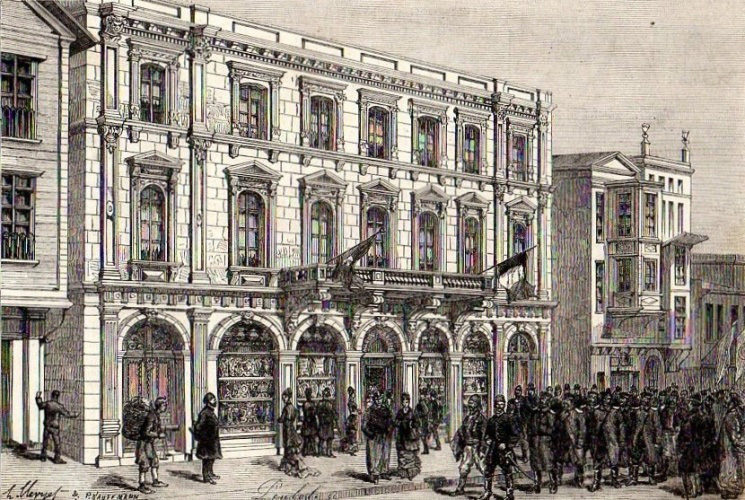
The Alléon ‘winter palace’, 354, Grand Rue de Péra
The Alléon ‘summer palace’, in Büyükdéré
Postcard views of the northern end of Büyükdere showing the former Alléon summer palace, in the middle of the row, that was standing till at least the early 1920s. The site is now occupied by a small single-storey building of no interest, operated by a restaurant. - further information:
The only trace still visible in the city is the Alléon passageway, the name given to the two cross-shaped alleys that separate the buildings of the same name, which still exists and has 48 apartments, although the spelling has been altered to become Alyon Geçidi. Finally, there is still a chapel in the crypt of the Saint-Esprit cathedral, where five generations of Alléon are buried, well out of sight.
From Jean-François to Abel, they are all there, together. Pera was their town. They rest there discreetly.
The chapel of the Alléon family, in the crypt of the Saint-Esprit cathedral
Sources
- Archives of French Ministry of Foreign Affairs, Department of Historical Archives, Paris (Memoirs and Documents, Turkey: Political Correspondence, Turkey).
- Archives of the French Ministry of Foreign Affairs, Centre des archives diplomatiques, Nantes (series E, finances).
- Archives of the Chamber of Commerce and Industry of Marseille, including the old fonds, series J and the new fonds, series M.Q.5.1.
- “Biographical note on Count Amédée Alléon.” Article by Paul Leverkuhn, published in the Ornis of March 1904
- “A French merchant in Constantinople during the French Revolution, Jacques Alléon.” Article by Christophe Alléon, published in the INALCO alumni newsletter of May 2003 - view translation:
- “An apothecary from Ardèche in Constantinople, Jean-François Alléon.” Article by Christophe Alléon, published in the INALCO alumni newsletter of November 2002 - view translation:
For more information, please contact the author of this page (), who will gladly exchange events and anecdotes about the families mentioned.

